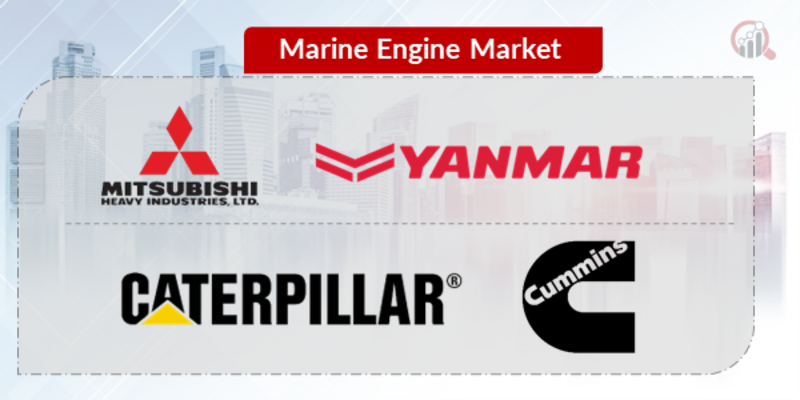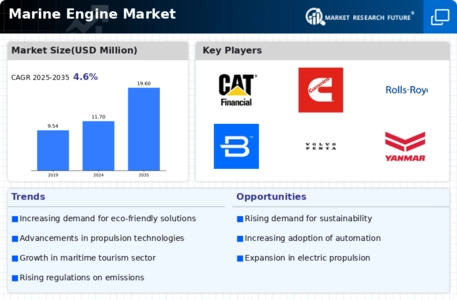Top Industry Leaders in the Marine Engine Market

*Disclaimer: List of key companies in no particular order
The global marine engine sector operates within a intricate and dynamic environment. Driven by the escalating demand for international freight transport, this market displays consistent growth, notwithstanding challenges from environmental regulations and technological disruptions. In this tumultuous landscape, both established and new players compete for supremacy, employing varied strategies to secure their portion of the market.
Key strategies of major players include:
Established Giants at the Helm: A few dominant players, such as Caterpillar, MAN Energy Solutions, Wartsila, Cummins, and Mitsubishi Heavy Industries, collectively hold a substantial market share. Their competitive strategies encompass:
-
Product Diversification: Offering a diverse range of marine engines to cater to different vessel types and power requirements. -
Technological Advancements: Investing in continuous research and development to enhance fuel efficiency, reduce emissions, and improve operational reliability. -
Global Presence: Maintaining extensive service networks and spare parts availability in strategic maritime hubs to provide prompt support and minimize operational downtime. -
Strategic Collaborations: Forming partnerships with shipyards, technology providers, and research institutions to stay informed about market trends and develop innovative solutions.
New Entrants Making Waves: While established players dominate, new entrants are disrupting the status quo by innovating in niche segments and capitalizing on emerging trends such as:
-
Alternative Fuel Engines: Startups are introducing engines powered by cleaner alternatives like LNG, methanol, and hydrogen to meet the demand for sustainable solutions. -
Digital Disruption: Tech-savvy companies are developing AI-powered optimization tools and remote monitoring systems to enhance engine performance and operational efficiency. -
Regional Focus: Smaller players are carving out niches by focusing on specific geographies with unique needs and regulations.
Factors Influencing Market Share Analysis: Analyzing market share requires considering factors such as ship segment, geographical markets, and aftermarket services. The type of vessel, regional regulations, and the availability of spare parts and technical support significantly impact customer loyalty and brand preference.
Emerging Trends: Several trends are shaping the future of the marine engine market, including:
-
Environmental Pressures: Stringent regulations and a growing focus on sustainability are driving the adoption of cleaner technologies and alternative fuels. -
Digitalization: Integration of AI, big data, and automation is enhancing engine performance, optimizing fuel consumption, and reducing emissions. -
Focus on Efficiency: Ship owners are increasingly demanding cost-effective solutions, driving advances in engine efficiency and operational optimization.
Competitive Horizon: Rough Seas Ahead: The competitive landscape of the marine engine market is evolving, with established players, startups, and disruptive technologies vying for dominance. As environmental regulations tighten and digitalization advances, the battle for market share is expected to intensify. Companies that adapt to these trends and offer sustainable and efficient marine propulsion solutions are likely to emerge as leaders in this complex and ever-evolving market.
Industry Developments and Latest Update: Notable developments from key players include GE Transportation's joint venture with Rolls-Royce for fuel-efficient LNG engines, Caterpillar Marine supplying Maersk with Tier III IMO 2023 compliant engines, Cummins partnering with Damen Shipyards for hydrogen fuel cells, Rolls-Royce supplying MTU engines for new cruise ships, and MAN Diesel & Turbo's ME-RT methanol dual-fuel engine receiving IMO Tier III certification for clean shipping.









